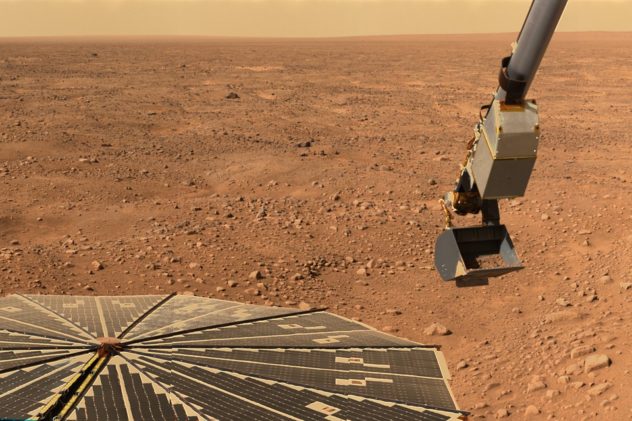Vocabulary:
- mission /MISH-uhn/
- profound /pruh-FOUND/
- illustration /il-uh-STREY-shuhn/
- aspiration /as-puh-REY-shuhn/
- depict /dih-PIKT/
[noun] an important job, especially a military one, that someone is sent somewhere to do
The secret agent had an important mission in which he would need to pretend to work for the enemy.
[adjective] felt or experienced very strongly or in an extreme way
Mr. Garcia’s profound words of encouragement inspired John to attend college.
[noun] a picture in a book, magazine, etc. or the process of illustrating something
The kite must be assembled as shown in the illustration.
[noun] something that you hope to achieve
She was filled with aspirations to succeed in life.
[verb] to represent or show something in a picture or story
Aliens are often depicted with dark, almond-shaped eyes.
The National Aeronautics and Space Administration’s (NASA) InSight (Interior Exploration using Seismic Investigations, Geodesy and Heat Transport) mission documented a series of profound sounds on Mars. The mission, which landed on November 2018, placed the stationary probe’s seismometer to listen to the red planet’s quakes. It has detected more than 100 events since April. According to the researchers, 21 of them are possible marsquakes and a sound of wind. Seismic movements can form an illustration of the internal part of a planet and how it was structured, which is one of the aspirations of the mission.
The crust of Mars’ surface is disparate from the Earth’s because it does not have tectonic plates that generate quakes, rather caused by cooling and shrinkage, which form fissures on its crust. InSight’s arm makes friction and produces fascinating sounds like whistling and “dinks and donks”, a nightfall sound due to heat loss. “It’s been exciting, especially in the beginning, hearing the first vibrations from the lander,” said Constantinos Charalambous, an InSight science team member at Imperial College London. He also announced that we can depict everything on Mars as InSight sits on the open landscape.
The crust of Mars’ surface is disparate from the Earth’s because it does not have tectonic plates that generate quakes, rather caused by cooling and shrinkage, which form fissures on its crust. InSight’s arm makes friction and produces fascinating sounds like whistling and “dinks and donks”, a nightfall sound due to heat loss. “It’s been exciting, especially in the beginning, hearing the first vibrations from the lander,” said Constantinos Charalambous, an InSight science team member at Imperial College London. He also announced that we can depict everything on Mars as InSight sits on the open landscape.
True or False:
- NASA’s InSight mission landed in November 2017 on Mars.
- The seismometer collected more than 100 events including radioactive waves and quakes.
- Both Mars and Earth’s crusts have tectonic plates that generate quakes.
- InSight’s arm makes friction and produces fascinating sounds like whistling and “dinks and donks”, a nightfall sound due to heat loss.
- Constantinos Charalambous announced that we can depict everything on Mars as InSight sits on the open landscape.
Discussion Questions:
- What can you say about the strange sounds recorded by NASA’s InSight? Elaborate your answer.
- Do you think those captured sounds will cause a new phenomenon regarding the Martian planet? Why or why not?
- In your opinion, what is the essence of deploying seismometers to planets?
- Do you believe that Mars can be the next Earth? Please explain your answer.
- What do you think are the similarities and differences between Earth and Mars? Elaborate your answer.
Express Your Opinion:
- “Mars is there, waiting to be reached.”– Buzz Aldrin
- “Eventually, man has to get there (Mars) because we will never be satisfied with unmanned exploration.” – Cyril Ponnamperuma
- “Someday people will travel to Mars. It will be a long trip, but fun. This will be a big step for mankind. We would be able to find out if there was life on this planet. It probably will look like a red desert.” – J. Stephen Hartsfield
